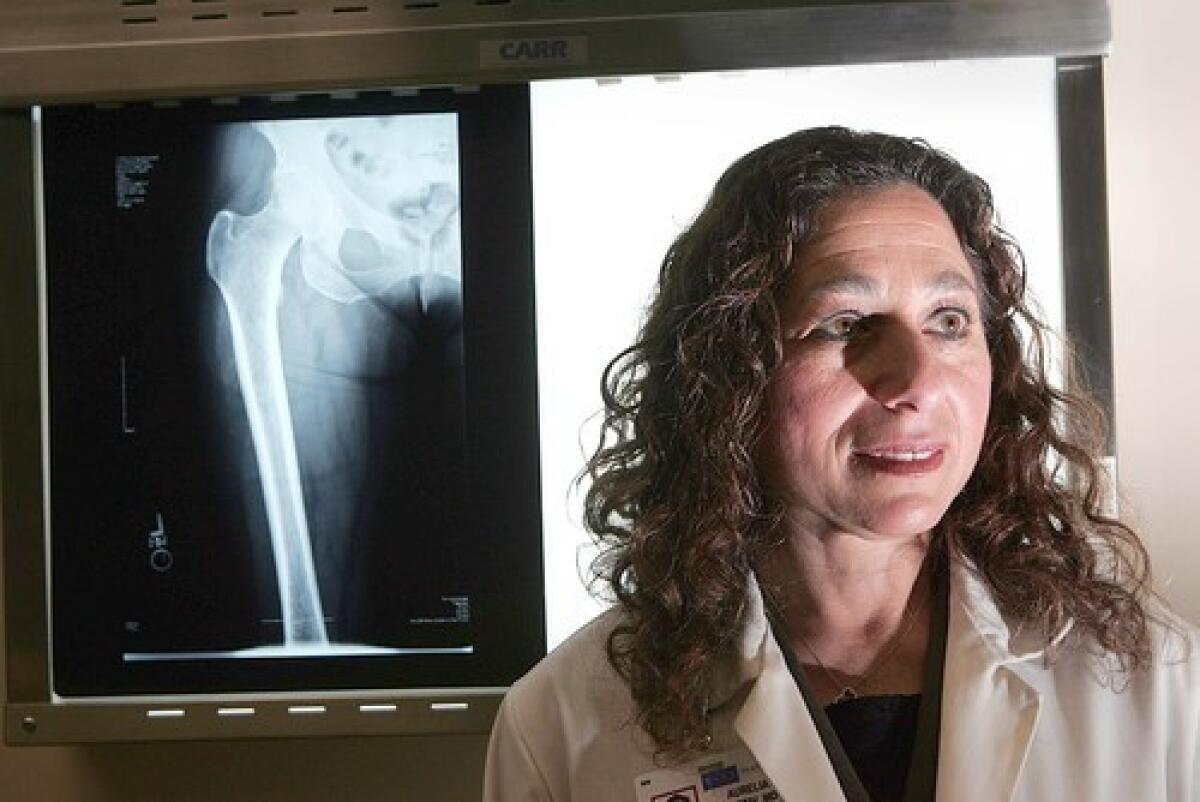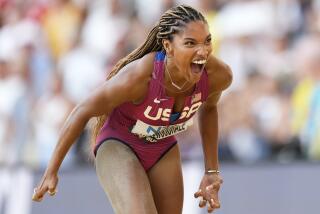An invisible enemy in a runner’s stride

The adage “what doesn’t kill you makes you stronger” doesn’t always apply to distance runners.
Promising running careers can be interrupted or cut short -- and training goals derailed -- by overuse injuries known as stress fractures. Repeated pounding causes these tiny breaks in bones in the feet, legs and hips.
Even casual runners aren’t immune. Seven-time Tour de France winner Lance Armstrong suffered through a stress fracture when he ran the New York Marathon for the first time after retiring from cycling competition.
Runners, coaches and sports medicine experts alike are trying to figure out how athletes can train hard without risking these painful injuries. At UCLA, researchers are attempting to establish what predisposes runners to stress fractures in order to prevent them.
“Normally, running is good for bones, but more is not always better,” says Dr. Aurelia Nattiv, a professor at the David Geffen School of Medicine at UCLA and a physician for the UCLA track and field team.
She and her colleagues studied 167 male and female volunteers from UCLA track and field teams to determine individual risk factors for stress fractures. The athletes received annual physical exams, filled out health questionnaires and food diaries, provided blood samples and had their strength, flexibility and bone density assessed. The study was funded by the UCLA General Clinical Research Center, the U.S. Olympic Committee and USA Track & Field.
During the course of the five-year study, 37 of the athletes suffered more than 60 stress fractures.
The data have not yet been published, but Nattiv has presented preliminary results to the American College of Sports Medicine and the American Medical Society for Sports Medicine, as well as in meetings with UCLA and the U.S. Olympic Committee coaches.
“In the past, studies have focused on [bone density] being a risk factor for female athletes, but we’re seeing it in the male athletes as well,” says Nattiv. “We’re also looking at weight, and it appears that that plays an important role in men as well as women.”
The study also confirmed that having a prior stress fracture is an important risk factor for having another and that eating disorders can predispose runners to stress fractures.
Nattiv prefers the term “bone stress injury” to stress fracture because of the continuum from normal bone to bone fatigue and, with more stress, to actual fracture. The injury results when there is a disturbance in the natural equilibrium between bone formation and bone loss, resulting in weakened bone that is unable to withstand repetitive stress.
The first sign of a stress fracture is often pain in the feet, legs or hips when running or walking. Tenderness from the bone stress injury is usually localized, though pain from tendinitis -- tendon inflammation sometimes confused with bone pain -- is more diffuse. Standard X-rays miss more than 70% of stress fractures, so MRIs and CT scans are needed for early and accurate diagnosis.
Early diagnosis is beneficial. The study found that runners with fracture lines visible on an MRI had a longer recovery time than those with a stress reaction but no fracture.
Although men and women suffer from stress fractures, women may be at higher risk because of what is called the “female athlete triad” -- disordered eating, menstrual dysfunction and osteoporosis. Recent studies have shown that not replenishing energy consumed by exercise with adequate caloric intake may lead to the menstrual problems and poor bone health.
“A typical scenario is a lean female athlete who is trying to be thinner because she thinks being thinner will increase her chances of running faster,” Nattiv says. “She . . . runs to the point where she loses her period.”
Some athletes also skip meals to drop weight, and because of poor nutrition and hormonal changes they fail to make healthy bone.
“We know that estrogen is needed for bone health,” says Nattiv, who also directs the Osteoporosis Center at UCLA. Female athletes who lose their periods often have a very low estrogen level, which plays a role in decreased bone density and stress fractures.
Eric Peterson, coach for UCLA’s distance runners, says such women are running on borrowed time.
“Once you get to an unhealthy state, an injury is going to develop,” Peterson says. “It’s one thing to break a bone in your foot due to a stress fracture, but it’s an entirely different thing to break a bone in your sacrum or in your spinal column because of low bone density.” At that point athletic performance takes a secondary role to concerns about long-term health, Peterson says.
Nattiv recommends that athletes do more strengthening exercises (using weights) and plyometric exercises, and that coaches pay close attention to athletes with risk factors such as low weight, poor nutrition and disordered menstrual patterns.
For most distance runners who don’t get enough calcium in their diets, she suggests taking 1,500 milligrams of calcium and 400 to 800 IU of vitamin D daily. Cross training -- mixing activities that give bones different stresses -- can also help strengthen bones.
Peterson likes to call this “prehabilitation” -- identifying runners’ problems and addressing them before injuries occur and rehabilitation is required.
Because typical runners usually won’t get the same kind of care and attention as college athletes, Nattiv suggests that those who have had a previous stress fracture get a bone-density assessment before resuming their runs. Women should try to ensure they have regular menstrual cycles (a hallmark of a healthy diet and lifestyle).
And all runners should pay attention to good nutrition, run on softer surfaces in good shoes, not overdo the mileage -- and see a doctor sooner rather than later should they start to feel a twinge in the bones.
--
Preventive measures
To avoid stress fractures, follow these suggestions from sports medicine experts:
* Don’t “push through” pain. If a foot, leg or hip hurts, stop exercising and rest.
* If, after several days of rest, the pain persists when walking or running, consult a physician.
* Avoid sudden, extreme changes in exercise patterns. Start slowly and increase intensity and duration gradually.
* Eat a diet that includes plenty of calcium and vitamin D and enough calories for your activity level.
* Consider both calcium and vitamin D supplements, especially when adequate amounts are missing from your diet and exposure to the sun is limited.
* Get medical care for any sign of disordered eating, low weight in relation to height or, for women, irregular periods.
* Choose appropriate footwear for your activity.
* Replace athletic shoes when cushioning is worn thin.
-- Bill Becher
More to Read
Go beyond the scoreboard
Get the latest on L.A.'s teams in the daily Sports Report newsletter.
You may occasionally receive promotional content from the Los Angeles Times.




